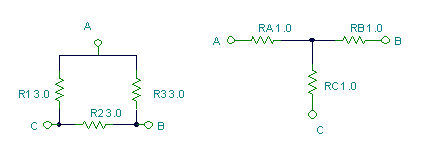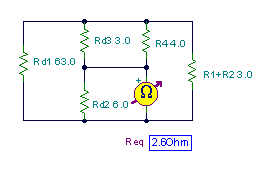 Click or Tap the Example circuits below to invoke TINACloud and select the Interactive DC mode to Analyze them Online.
Click or Tap the Example circuits below to invoke TINACloud and select the Interactive DC mode to Analyze them Online. Get a low cost access to TINACloud to edit the examples or create your own circuits
In many circuits, resistors are neither in series nor in parallel, so the rules for series or parallel circuits described in previous chapters cannot be applied. For these circuits, it may be necessary to convert from one circuit form to another to simplify the solution. Two typical circuit configurations that often have these difficulties are the wye (Y) and delta ( D ) circuits. They are also referred to as tee (T) and pi ( P ) circuits, respectively.
Delta and wye circuits:

And the equations for converting from delta to wye:



The equations can be presented in an alternate form based on the total resistance (Rd) of R1, R2, and R3 (as though they were placed in series):
Rd = R1+R2+R3
and:
RA = (R1*R3) / Rd
RB = (R2*R3) / Rd
RC = (R1*R2) / Rd
Wye and delta circuits:

And the equations for converting from wye to delta:


An alternate set of equations can be derived based on the total conductance (Gy) of RA, RB, and RC (as though they were placed in parallel):
Gy = 1/RA+1/RB+1/RC
and:
R1 = RB*RC*Gy
R2 = RA*RC*Gy
R3 = RA*RB*Gy
The first example uses the delta to wye conversion to solve the well-known Wheatstone bridge.
Example 1
Find the equivalent resistance of the circuit !

Notice that the resistors are connected neither in series nor in parallel, so we can’t use the rules for series or parallel connected resistors
Let’s choose the delta of R1,R2 and R4:and convert it to a star circuit of RA, RB, RC.
Using the formulas for the conversion:

After this transformation, the circuit contains only resistors connected in series and parallel. Using the series and parallel resistance rules, the total resistance is:

Now let’s use TINA’s Interpreter to solve the same problem, but this time we will use wye to delta conversion. First, we convert the wye circuit consisting of R1, R1, and R2. Since this wye circuit has two arms of the same resistance, R1, we have only two equations to solve. The resulting delta circuit will have three resistors, R11, R12, and R12.
:
Gy:=1/R1+1/R1+1/R2;
Gy=[833.3333m]
R11:=R1*R1*Gy;
R12:=R1*R2*Gy;
Using TINA’s function for parallel impedances, Replus:
Req:=Replus(R11,(Replus(R12,R3)+Replus(R12,R4)));
Req=[4.00]
Replus= lambda R1, R2 : R1*R2/(R1+R2)
Gy=1/R1+1/R1+1/R2
print(“Gy= %.3f”%Gy)
R11=R1*R1*Gy
R12=R1*R2*Gy
print(“R11= %.3f”%R11)
print(“R12= %.3f”%R12)
Req=Replus(R11,Replus(R12,R3)+Replus(R12,R4))
print(“Req= %.3f”%Req)
Example 2
Find the resistance shown by the meter !
Let’s convert the R1, R2, R3 wye network to a delta network. This conversion is the best choice for simplifying this network.
First, we do the wye to delta conversion,
then we notice the instances of paralleled resistors
in the simplified circuit.
{wye to delta conversion for R1, R2, R3 }
Gy:=1/R1+1/R2+1/R3;
Gy=[95m]
RA:=R1*R2*Gy;
RB:=R1*R3*Gy;
RC:=R2*R3*Gy;
Req:=Replus(Replus(R6,RB),(Replus(R4,RA)+Replus(R5,RC)));
RA=[76]
RB=[95]
RC=[190]
Req=[35]
Replus= lambda R1, R2 : R1*R2/(R1+R2)
Gy=1/R3+1/R2+1/R1
print(“Gy= %.3f”%Gy)
RA=R1*R2*Gy
RB=R1*R3*Gy
RC=R2*R3*Gy
Req=Replus(Replus(R6,RB),Replus(R4,RA)+Replus(R5,RC))
print(“RA= %.3f”%RA)
print(“RB= %.3f”%RB)
print(“RC= %.3f”%RC)
print(“Req= %.3f”%Req)
Example 3
Find the equivalent resistance shown by the meter !
This problem offers many possibilities for conversion. It is important to find which wye or delta conversion makes the shortest solution. Some work better then others while some may not work at all.
In this case, let’s start by using delta to wye conversion of R1, R2 and R5. We will next have to use wye to delta conversion. Study the Interpreter equations below carefully
- for RAT, RB, RCT:

Rd:=R1+R2+R5;
Rd=[8]
RC:=R1*R5/Rd;
RB:=R1*R2/Rd;
RA:=R2*R5/Rd;
{Let be (R1+R3+RA)=RAT=5.25 ohm; (R2+RC) = RCT = 2.625 ohm.
Using a wye to delta conversion for RAT, RB, RCT !}
RAT:=R1+R3+RA;
RCT:=R2+RC;
Gy:=1/RAT+1/RB+1/RCT;
Rd2:=RB*RAT*Gy;
Rd3:=RB*RCT*Gy;
Rd1:=RCT*RAT*Gy;
Req:=Replus(Rd2,(Replus(R4,Rd3)+Replus(Rd1,(R1+R2))));
Req=[2.5967]
Replus= lambda R1, R2 : R1*R2/(R1+R2)
Rd=R1+R2+R5
RC=R1*R5/Rd
RB=R1*R2/Rd
RA=R2*R5/Rd
RAT=R1+R3+RA
RCT=R2+RC
Gy=1/RAT+1/RB+1/RCT
Rd2=RB*RAT*Gy
Rd3=RB*RCT*Gy
Rd1=RCT*RAT*Gy
Req=Replus(Rd2,Replus(R4,Rd3)+Replus(Rd1,R1+R2))
print(“Req= %.3f”%Req)



